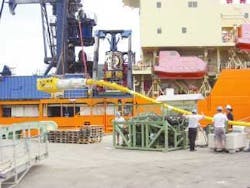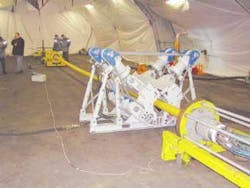Program models deepwater stresses
Nick Terdre
Contributing Editor
Cable specialist Nexans is best known to the offshore sector for its subsea products, notably umbilicals, power cables, and pipeline heating systems. To meet growing requirements for ultra-deepwater products in particular, the company is pushing the technological envel-ope, according to Ragnvald Graff, manager for offshore subsea products and services.
Recently, Nexans delivered 130 km of umbilicals for the deepest umbilical installation to date, in 2,316 m of water, at Shell's Na Kika project in the Gulf of Mexico. It also has a frame agreement with BP, which will involve supplying 65 km of umbilicals for the Thunder Horse project in 1,880 m water depth, followed in 2006 by 45 km of umbilicals for the Atlantis project, in 2,134 m. Extensive qualification testing has been carried out for all three projects. Meanwhile, the company has qualified an umbilical for Petrobras for operation in 2,000 m on the Roncador field in the Campos basin.
null
These depths approach the limit that current umbilicals can withstand. A change in design will be required to take them into deeper waters, where they will be subject to even higher loadings, according to Sales Manager Bjørn Bjørnstad.
To this end, Nexans has developed a program for modeling the effects of stress and strain on an umbilical. "Our computing tools give a full understanding of what is happening at all parts of the umbilical," he says, "both in installation and operation, and provide a good basis for moving into more demanding conditions, identifying the critical elements, load cases, and so on."
In ultra-deepwater, the umbilical's passive components – fillers – are not a cause of concern. However, steel tubes may be, as their loads exceed their tensile strength. The tube walls can be thickened, but at some point the increased weight will cause problems during installation. Another solution could be to combine them with other materials. The quads also present challenges, as copper, with its low yield strength, cannot withstand high tensile loads.
Weight is another issue – a complex umbilical can weigh up to 30 kg/m. In depths of 2,500 m, the dynamic section of such an umbilical will weigh over 75 metric tons in air, presenting problems both in installation and during operation. Composite materials represent a possible solution to reducing weights to acceptable levels.
Sheathing is another area that requires study, although current materials may prove adequate. The interstices of the umbilical need to be flooded to ensure that pressure is equalized across the umbilical, so it is important to ensure that the characteristics of the outer serving allow proper flooding, Bjørnstad says.
Umbilicals are also getting longer. At its plant at Halden in southern Norway, which also doubles as its competence center for submarine cables, Nexans is storing a 90-km umbilical for Enterprise Energy Ireland's suspended Corrib project off Ireland. The company has also been contracted to supply a 165-km umbilical in a single length – the longest yet developed – for Statoil's Snøhvit development off northern Norway.
According to Graff, one of the constraints on umbilical length is the capacity of the installation equipment. The Nexans-operated installation vessel,Bourbon Skagerrak, can carry up to 6,500 tons of cable. For an umbilical weighing a typical 25 kg/m, that equates to a length of 260 km – beyond any offshore specification to date.
Direct heating, power cables
The company is now working on its third order for a pipeline direct heating system, for Statoil's Kristin gas/condensate field development in the Norwegian Sea. This system was designed to provide protection against paraffin and hydrate build-up in subsea pipelines, in the form of a cable strapped to the outside of the pipeline. Alternating current passes down the cable and returns through the pipe wall, heating the wall and the pipeline contents.
Nexans has also supplied direct heating systems to Statoil's Åsgard and Huldra gas/ condensate fields. These systems are designed to maintain the respective pipeline contents at temperatures of 27° C and 37° C. An AC-based direct heating system is suitable for pipeline lengths of up to 30-40 km, Bjørnstad claims.
Another specialty is submarine power cables. Nexans' latest deliveries were to Shell projects offshore Nigeria – 40 km of 36 kV cable to the Forcados Yokri project in 2002 and 18 km of 17 kV cable to the EA project. Here Nexans is working to overcome an important limitation of the technology. In terms of water depth, the state-of-the-art for dynamic power cables is 500 m, while the limit for cables based on traditional designs is around 1,000 m. Among the constraints are the low yield strength of copper, which requires an increasing amount of protection as depths increase, and the weight of steel armoring employed to provide that protection. Static power cables based on current technology may not be able to go much deeper, given the loads they are exposed to during installation.
null
These limits have to be extended, however, to accommodate deepwater subsea production facilities of the future, such as seabed processing, pumping, and pipeline heating. For these to be applied on a large scale, substantial amounts of power will have to be provided at depths beyond 1,000 m.
Composites could provide solutions for deepwater power cables, according to Bjørnstad, and materials like Kevlar have good tensile strength properties. For the conducting cable, some alloys could provide a higher tensile strength than copper. Nexans is already testing alternative materials, which may lead to design modifications.
Next year, theBourbon Skagerrak will install a power cable in the Arabian Gulf for Saudi Aramco, extending its full load capacity – six cables with a total length of 120 km. Nexans is also scheduled to install four 67-km lengths of power cable from the Norwegian west coast to Statoil's Troll A platform for ABB, using the Edda Fjord cable-layer.
Cable and pipeline trenching is performed using the company's Capjet system, a remotely operated vehicle that employs water jetting technology. The system was applied to trench some 230 km of umbilicals, pipelines, and flexible lines on Norsk Hydro's Troll oil development in 1997-2000. This year Capjet will be used to trench a 46-km, 10.8-in. inshore pipeline in Norway for Stolt Offshore. The total length of cable, umbilical, and pipeline trenched by Capjet over the years is 3,500 km. The system is being considered for the unusual job of evening out the rugged terrain on the pipeline trajectory of Norsk Hydro's Ormen Lange development.
Finally, seismic reservoir monitoring is proving an increasingly effective tool for reservoir management. In 1995, in association with Geco Prakla, Nexans produced and installed the first full-scale 4D ocean bottom cable system for BP's Foinaven field in the UK sector of the North Sea. In collaboration with Sercel, a subsidiary of the CGG seismic company, it has now completed the development of a deepwater ocean bottom system known as Deep Sea Link, which was tested last year at a depth of 500 m in a Norwegian fjord.






